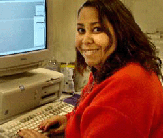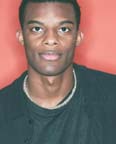> WAI Web site redesign project
> UCD Analysis Summary
Version: 2004.03.22
Note: This Web page is a working draft
and should not be referenced or quoted under any circumstances.

I'm just not sure which guidelines to follow. What's the difference
between the national standards and the WAI guidelines?
Age: 32
Position: Web site developer
Organization: Independent
[@@ add that she prides herself on visual design of her Web sites, maybe even has grahpic design background @@]
Martina Prado is married and has 2 children (aged 8 and 10). She works hard to balance her personal and professional life while working from home. She studied English in university and then got into computers during the internet "boom" times. She has managed to keep her company going during the recent recession, and wants to position her company for future growth as the economy recovers. Her personal goal is to build her business to a point where she can spend more time with her children before they leave for university. To do this she feels that she needs to be very knowledgeable about all areas of web development including accessibility.
Martina handles a wide variety of responsibilities including: one-on-one client meetings, programming, project management, Web site design, etc. Martina has been able to keep her computer system up-to-date, adding new software when needed for clients, while having enough space to keep older versions as well. She is in multiple listserv-type groups and uses the contacts she's made through these groups as a support team when she has computer trouble. Martina is very creative and adventurous. She loves to try new things, and even makes her own greeting cards using her computer.
Martina recently had a client ask about compliance with their national standards, and in talking to other Web developers about the subject she found out about WCAG. She's somewhat familiar with the general ideas of both, she's just not sure which could work best for her customers. She's not sure what the difference is between the two guidelines and she also is looking for information she can use to convince her customers of the added value of having an accessible Web site, so she can add it to her company's services.

I have a deadline, and it's
not like we have any disabled users anyway. I looked at the server logs, I
should know.
Age: 34
Position: coder
Organization: Medium sized food packaging company
Andy Petroff is "elite", a hardcore code monkey. He runs the Web servers, and codes on the Web site. The most technical guy in the company he takes the lead with technical decisions. He thinks all this accessibility stuff is just PC BS it's not like people with disabilities ever come onto his site.
Potential: Andy doesn't see the need for accessibility. His boss heard about it and told him to check it out. However since Andy is the only person who knows how to do the Web sites ultimately it's his decision. Unless he sees the need for it he isn't going to waste his time, after all this is just a 9 till 5 job. He has better things to do at night with a Linux kernel.
I am supposed to find information for the vice president about
accessibility for a report. I know from my work with programs on campus that
this is an important issue for us as an institution.
Age: 52
Position: executive assistant
Organization: university executive office
[@@ expand to writing a university policy, then some policy overlap as well @@]
Ms. Weesaw knows how to do word processing. She can save a word processing file to HTML. She does not know how to make a Web page from scratch or how to use a Web page creation software ("authoring tools") but she is very capable and a fast learner. She has heard that accessibility is important but she doesn't really know any technical details.
Ms. Weesaw has to gather information about Web accessibility for her boss, a University vice president. The Web accessibility information will be used to as part of the University's new Web publishing guidelines, which are currently being developed.
Recently, Ms. Weesaw has begun to experience some difficulty with repetitive stress injury (RSI) from typing and she has had to increase the font size to view on-screen documents due to age-related vision deterioration.
Potential: Ms. Weesaw could become a key advocate in the University for accessibility from her personal experience and through her connections in various advocacy groups. Right now, she is just concerned about pulling together the report. She feels overwhelmed by her lack of technical experience and understanding. She also feels overwhelmed by the amount of information that is available and is befuddled as to what is and is not important. If there were something really simple to look at or a key to all the information, it wouldn't be so hard. As it is, accessibility is something she wishes she had a whole lot more time to learn about or a much easier way to figure out what is important.
The personas below cover the user groups that:

I just want to make sure my
design looks good, but I have to follow these standards, too.
Age: 26
Position: graphic designer
Organization: Small Web design company
Marc Blake spent a lot of work on this project doing what he does best, graphic design. He knows he has to make it accessible too but his design comes first. He has't really thought about the accessibility much, and finds the documents rather too long. He might buy a book on the subject but is more likely to buy a new game for his Play Station 2.
Potential: Marc loves design and he could get used to making all his sites with accessibility in mind. Making great looking sites isn't 9 to 5 for Marc so he really does want to do the best job he can. Right now though he thinks accessibility just gets in the way.

"I need to be up with current bleeding-edge accessibilty thinking and
have definitive answers. Plus I want to get involved"
Age: 47
Position: Web accessibility and usability consultant
Organization: Independent
Willam Travis understands code web pages to the extent that he can get by comfortably, but he is not a coder and has no interest in becoming one. He performs accessibilty audits and offers advice to client teams - from management level to the techies. He also works hard to promote accessibilty - because its the right thing to do, and also to give himself a competitive edge and increase his client base.
When he started off in the accessibility field WAI was the first port of call, and he recognizes it as the authority. He now increasingly finds the latest techniques and best practice from other sources but would like to know what the "official" line is.
Potential: William is an accessibility advocate so does not need convincing, but he needs to convince others. He needs to be able to trust the WAI site to provide the up-to-date information he requires or point him in the right direction. He needs clear cut answers to conformance issues, and reference material from a definitive public source. He finds that, even though he is not a coder, the coders ask him for technical solutions - so he needs to have the latest technical and "best-practice" information available for referral. He needs to be convinced that the WAI site is his primary reference now and in the future. He could potentially be an asset by getting involved in a WAI working group.

I haven't got time to mess
around. I need to know where we stand, legally speaking.
Age: 28
Position:Manager
Organization: Large enterprise industrial company
Jessica Pratner likes power suits, power meetings and power bars for power lunches. She is responsible for risk management at her company. She wants to know where her company would stand in a lawsuit. She wants concise information that she can verify with the team responsible for the company intranet and Web sites.
Potential: Jessica is keen to see that her company is covered. She would probably be happy with the minimum needed to cover her bases. However she could easily be persuaded to push the Web development team that little bit further to achieve that extra level of compliance, and legal safety.

It would be nice to know what
I can expect from Web sites. I know they are supposed to help me but I don't
know how exactly.
Age: 19
Position: student
Organization: regional university
Mary Stone has a motor neuron condition which impairs her movement. Most of her friends say "Mary just walks a little funny" but she also has trouble with a mouse. Mary would love to know what Web sites are supposed to be doing for her but she isn't overly technical.
Potential: If Mary knew what was a reasonable amount of accessibility for Web sites to offer she might write a few letters when Web sites didn't meet those standards. She would probably complain to the faculty that their supposedly accessible Web site didn't really help her, and these people at the W3C said it wouldn't be to hard to fix.
I want to make sure that my students are prepared to deal with the real
world, whatever that will be for them.
Age: 37
Position: professor
Organization: university
Professor Zhang is aware of basic Web accessibility issues and thinks that it is important for his students to be aware of Web accessibility. He is also concerned that the students that are part of the virtual classes are able to easily share their work.
Professor Zhang wants easy access to information for himself, his staff, and his students so that they can all be ahead of the game now and in the future. He believes in being proactive but doesn't want it to take all day to find what is needed. While Professor Zhang read English very well, not all of his students do, so it is important the English resources are easy to understand by readers whose native language is not English.
Professor Zhang does some Web design himself and he requires each of his students to create a Web page as part of class so that they can share project information. He would like to have his administrative assistant and his students be able to find the Web accessibility information they need on their own.
Professor Zhang is an innovator. He likes to chart new territory but he is not a Web designer and is not interested in this consuming all of his time with Web accessibility. At the same time, he senses it is important for his own teaching, outreach, and research as well as for his students in their future careers. He is torn between high ideals, high time demands, and lack of reliable, succinct, usable information on Web accessibility.
I have to meet national Web accessibility standards and WCAG for my own
sites. For my consulting, I need a resource to help me in working with
product developers in research, industry, and education.
Age: 61
Position: professor, and industry policy consultant for
education, research, and business
Organization: university, and various businesses
Dr. Sathianathan is very near retirement. She taught herself HTML. Dr. Sathianathan created her own Web pages (for specific research projects and courses) and now has a couple of graduate students that help her maintain them.
Dr. Sathianathan has grants that require her Web sites to comply with national Web accessibility standards. The University requires that her Web sites meet W3C WAI WCAG 1.0, Priority 1 and Priority 2 Checkpoints. Dr. Sathianathan would like to have a list that shows the similarities and differences between the national standards and WCAG. She doesn't have time to research the differences herself, she doesn't want to spend a lot of time scanning multiple Web sites.
Potential: Dr. Sathianathan has a broad spectrum of off-campus clients in the research and business. Some are affiliated with either education or artificial language and technology field. Others are interested in the disabilities area but have little comprehension of the scope of the issues their customers might encounter with their products. Dr. Sathianathan has the potential to impact a large number of products at the development stage as well as to affect policy in research, education, and business.
@@ legislative assistant yet to be posted: http://lists.w3.org/Archives/Public/public-wai-eo-site/2004Jan/0023.html

I'm looking for a source that can give a concise definition of the term
accessibility and has information about the international guidelines how to
apply them, and statistics about how many Web sites follow them.
Age: 26
Position: Journalist
Organization: Daily Newspaper, South Africa
Caryn-Ann Robinson has a master's degree in journalism. She covers technology, and writes a weekly column on the subject. She really enjoys her job and her column has a fairly large audience. Her personal goal is to keep up her reputation for being highly knowledgeable and helpful to her readers with as little effort as possible. While she gets a lot of exposure through this column she makes more money doing news stories, so getting it done quickly is worth her while. She is watched carefully by many readers and they are quick to criticize if she makes a factual error, so she thoroughly researches subjects before writing about them.
Caryn-Ann is writing a critique of three new Web sites and one of the aspects she wants to analyze is accessibility. She's heard the term "Accessibility" used a lot lately, but few of her readers seem to understand it. She's looking for general information she can give to her readers and for specific Web pages that she can cite as references for those interested in the subject. When she visits the site she'll be looking not only for information to fill her column, but also for useful information for her readers.
@@ another reporter yet to be posted: http://lists.w3.org/Archives/Public/public-wai-eo-site/2004Jan/0023.html
These personas are fictitious. All characters, organizations, and opinions portrayed in the personas are fictional, and any resemblance to real people or organizations is purely coincidental.
@@ to do: check acronym tags, HTML & access check & validation
This Web page is under development by the WAI Site Task Force of EOWG. Primary contributors to the personas include Tom Croucher, Charmane Corcoran, Jon Dodd, Carol Smith, Matt May, and Shawn Lawton Henry. Last updated $Date: 2004/02/27 18:39:04 $ by $Author: shawn $
Some photos on this page are the copyrighted property of ArtToday, Inc. and are used with permission under license. These photos may not be copied or used without permission from ArtToday, Inc.